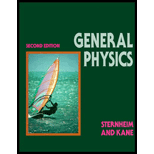
Concept explainers
(a)
To show that the minimum kinetic energy is larger than
(a)
Answer to Problem 48E
The energy of electron is
Explanation of Solution
Uncertainty principle states that the position and momentum of an atom cannot be measured simultaneously. It gives the uncertainty in position if we have uncertainty in momentum. The equation of uncertainty principle is given as
Here,
Rearrange the above expression for
Write the expression for energy.
Here,
Conclusion:
Substitute
Substitute
Thus, the energy of electron is
(b)
To see that the energy of neutron is greater than
(b)
Answer to Problem 48E
The energy of neutron is
Explanation of Solution
Uncertainty principle states that the position and momentum of an atom cannot be measured simultaneously. It gives the uncertainty in position if we have uncertainty in momentum. The equation of uncertainty principle is given as
Here,
Rearrange the above expression for
Write the expression for energy.
Here,
Conclusion:
Substitute
Substitute
Thus, the energy of neutron is
Want to see more full solutions like this?
Chapter 27 Solutions
General Physics, 2nd Edition
- An atom of iron has a radius of 156. pm and the average orbital speed of the electrons in it is about ×5.7*10^7 m/s. Calculate the least possible uncertainty in a measurement of the speed of an electron in an atom of iron. Write your answer as a percentage of the average speed, and round it to 2 significant digits.arrow_forwardThe radii of atomic nuclei are of the order of 5.0 * 10-15 m. (a) Estimate the minimum uncertainty in the momentum of a proton if it is confined within a nucleus. (b) Take this uncertainty in momentum to be an estimate of the mag- nitude of the momentum. Use the relativistic relationship between energy and momentum, Eq. (37.39), to obtain an estimate of the ki- netic energy of a proton confined within a nucleus. (c) For a proton to remain bound within a nucleus, what must the magnitude of the (negative) potential energy for a proton be within the nucleus? Give your answer in eV and in MeV. Compare to the potential energy for an electron in a hydrogen atom, which has a magnitude of a few tens of eV. (This shows why the interaction that binds the nucleus together is called the “strong nuclear force.”)arrow_forwardA proton is confined in a uranium nucleus of diameter 7.2 x 10-15 m. Use the energy-level calculation of a one-dimensional box that has length equal to the nuclear diameter to calculate the proton's minimum kinetic energy. What is the proton's minimum kinetic energy according to the uncertainty principle?arrow_forward
- The speed of a proton is measured to within an uncertainty of 1 × 103m/s. Calculate the length of the smallest region of space in which the electron can be confined.arrow_forward2.1. Find the de Broglie wavelength of the following particles: (i) an electron in a semiconductor having average thermal velocity at T = 300 K and an effective mass of me = amo, where a is a constant, (ii) a helium atom having thermal energy at T = 300 K, (iii) an a-particle (He4 nucleus) of kinetic energy 10 MeV.arrow_forwardThe "radius of the hydrogen atom" is often taken to be on the order of about 10-10m. If a measurement is made to determine the location of the electron for hydrogen in its ground state, what is the probability of finding the electron within 10-10m of the nucleus?arrow_forward
- Use the uncertainty principle to show that if an electron were confined inside an atomic nucleus of diameter 2 x 10-15 m, it would have to be moving relativistically, whereas a proton confined to the same nucleus can be moving nonrelativistically.arrow_forwardAn atom is in an excited state for 4.00 us before moving back to the ground state. Find the approximate uncertainty in energy of the photon in units of 10¹¹ eV. (A) 8.23 (B) 3.78 (C) 4.97 (D) 5.49 (E) 6.17arrow_forwardAn electron moves in the x direction with a speed of 3.6 x 10 m/s. We can measure its speed to a precision of 1%. With what precision can we simultaneously measure its x coordinate?arrow_forward
- We are going to use Heisenberg's uncertainty principle to estimate the ground- state energy of hydrogen. In our model, the electron is confined in a one- dimensional well with a length about the size of hydrogen, so that Ax = 0.0529 nm. Estimate Ap, and then assume that the ground-state energy is roughly Ap2/2me. (Give your answer in Joules or electron-volts.)arrow_forwardBy measuring the go-and-return time for a laser pulse to travel from an Earth-bound observatory to a reflector on the Moon, it is possible to measure the separation between these bodies. (a) What is the predicted value of this time? (b) The separation can be measured to a precision of about 15 cm. To what uncertainty in travel time does this correspond? (c) If the laser beam forms a spot on the Moon 3 km in diameter, what is the angular divergence of the beam?arrow_forward2.25 An electron moves with a constant velocity 1.1 × 106 m/s. If the velocity is measured to a precision of 0.1 per cent, what is the maximum precision with which its position could be simultaneously measured?arrow_forward
 Modern PhysicsPhysicsISBN:9781111794378Author:Raymond A. Serway, Clement J. Moses, Curt A. MoyerPublisher:Cengage Learning
Modern PhysicsPhysicsISBN:9781111794378Author:Raymond A. Serway, Clement J. Moses, Curt A. MoyerPublisher:Cengage Learning
